The Triumph Thruxton RS goes harder than anything this cool has any right to.
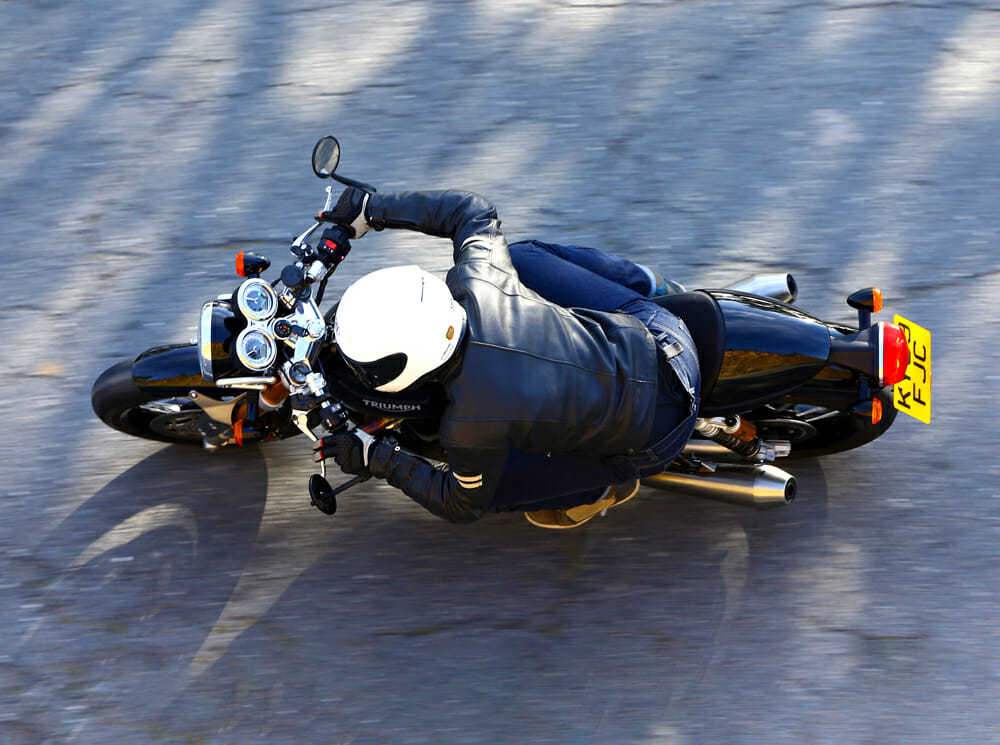
By Chris Northover
Photography by Gareth Harford & Chippy Wood
Remember when classic bikes were slow and heavy? Remember when buying a cool-looking bike used to mean accepting a lazy engine and basic suspension?
The retro bike world has changed a lot since the first “modern” Triumph Bonnevilles arrived in 2006, and now looking good doesn’t have to mean going slow. When the Triumph Thruxton R was launched in 2016, it brought speed and handling to the modern Bonnie, bridging the performance gap between it and bikes like BMW’s R nineT. This new Thruxton RS model takes that performance a step further, addressing some of the feedback from the R and wrapping it up in a slick blacked-out package.
VIDEO | 2020 Triumph Thruxton RS First Ride Review
We wreck the 2020 Triumph Thruxton RS. Or did we?
Three impossibly tight second-gear bends snake their way through the Portuguese mountains, carving side to side like they’re trying to shake me off their back. I enter way too fast for an old bike, the steel cradle chassis ties itself in a knot, each rear shock fighting the other for control; the road runs out, and the ditch offers a dusty embrace.
I lay there hoping that the tail rider doesn’t spot me, so I can prolong my embarrassing apology for wrecking a bike with only 300 miles on the tacho. At least, that’s what should have happened.
Instead, I throw the new Thruxton RS into the first turn, flick through the second, then immediately into the third, dragging boot at each apex before picking the front wheel up out onto the straight. This is sportbike nonsense; this is how you’re supposed to ride a Street Triple, not a damn retro café racer. What does the Thruxton think it’s playing at, holding a wheel high in the air through second, third and fourth gears? Silly Triumph, bad Triumph, awesome Triumph.
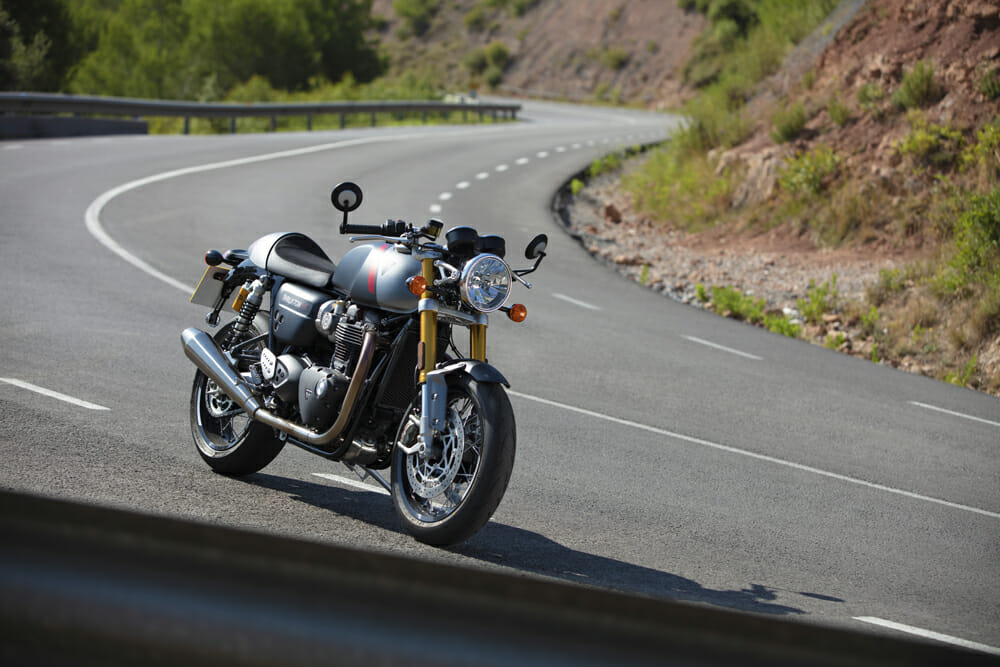
Under the skin
Triumph has taken the Thruxton R and tweaked the engine to rev a little higher, make more power and to spin up faster. Modifications to the crankshaft, clutch basket and alternator have reduced inertia of the engine by 20 percent—in English, that means it feels more responsive, more eager to pick up speed. Triumph proudly announced that the alternator now features a rare-earth magnet. Exactly the sort of technical fact a room full of seasoned motorcycle enthusiasts will nod approvingly at, united in the knowledge that it is definitely a good thing, while praying nobody actually asks them to explain it.
So, I asked one of the Triumph marketing staff, he laughed, handed me a beer and answered a different question. I hit up someone technical; determined not to be suckered into some industry-wide prank about rare-earth magnets being real, like Australians asking us to send money to save the drop-bears from the god-awful fires those guys are suffering.
It transpires that rare-earth magnet alternators are real, not something made up for a James Bond villain, and they’re simply a better, more efficient metal for making magnets out of. In this application, they allow the bike’s alternator to be smaller and lighter, yet still generate a magnetic field of the same strength and, hence, the same electrical power. Never underestimate the ability of the truth to suck all the fun out of a situation.
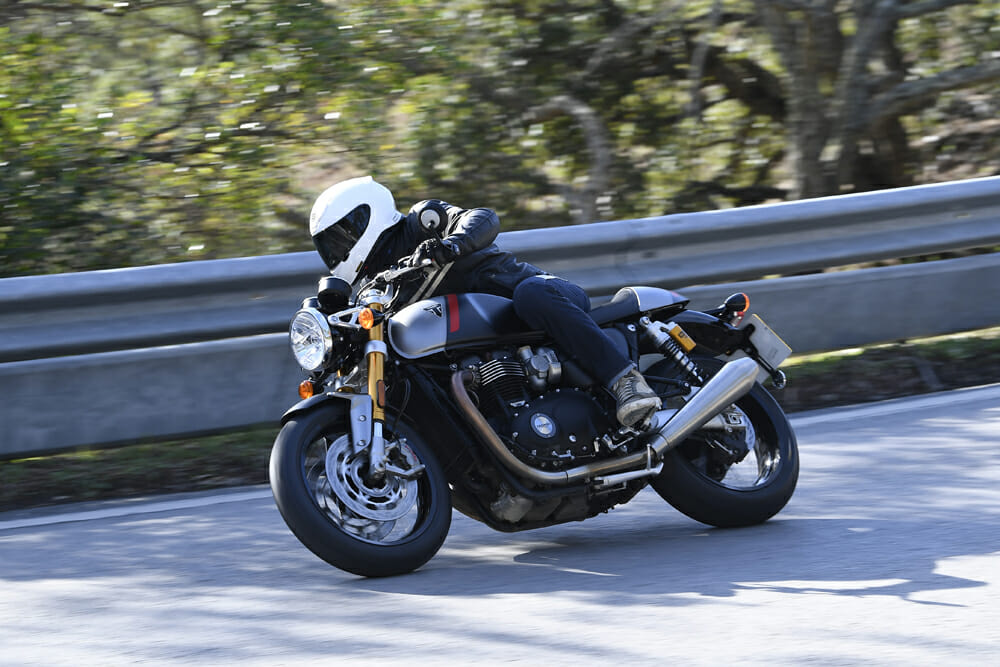
Where was I, ah yes, the new engine.
So super-mega-turbo alternator aside, there are new high-lift cams, a magnesium cam cover, lighter balance shafts, a lighter clutch and thinner-walled engine cases. The result is 103.5 horsepower, with more power everywhere post-5750 rpm. The 500 extra rpm at the top before you hit the rev-limiter takes care of the previous model’s propensity to do so. The power curve comparison does show a slight dip in power and torque around 4500 rpm compared to the old bike. I asked the Triumph grown-ups about this and they said it was down to the revised cam timing—nothing comes for free and to gain the extra revs and power up top, it cost a little bit of power around this mark. Out on the road it wasn’t noticeable, with the bike pulling cleanly whichever gear you threw at it.
Along with the want for more rpm, another bit of feedback Triumph has addressed with the Thruxton RS is the fueling from a closed to partially open throttle. The old bike’s habit of being a little abrupt, a little bit on/off in these conditions has been improved dramatically. In fact, I’ll go as far as saying that the fueling all round on the RS is sublime. It’s one of those rare bikes that you can leave in sixth gear, drop the revs right down and huck the throttle open with no juddering, no lurching and no protest from the motor. The clutch is lighter in both senses: physically to help the reduction in inertia and in its action at the lever thanks to a self-servo design.
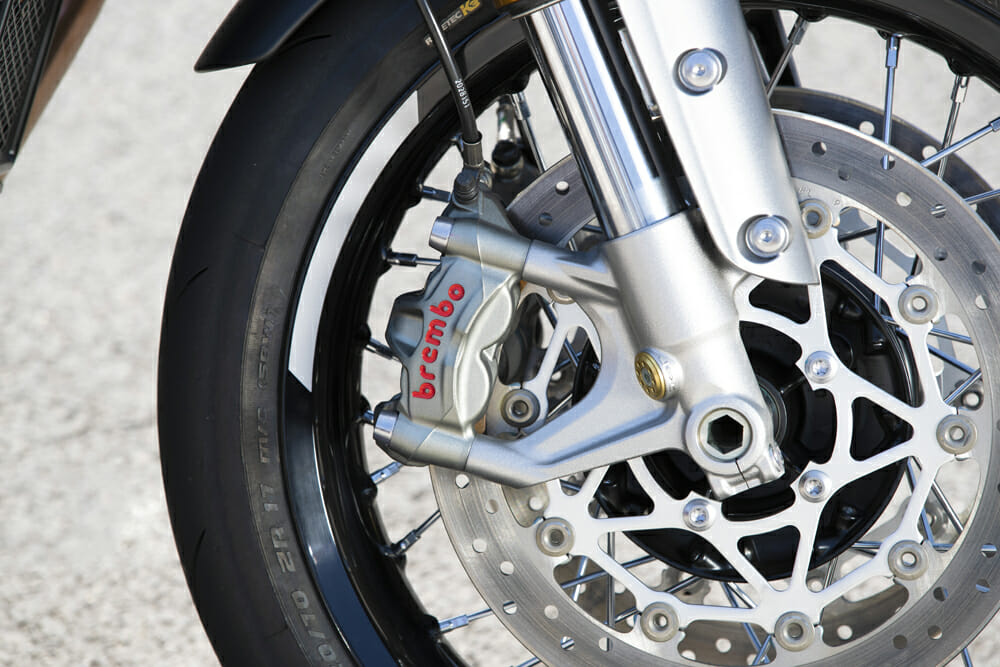
Outsmart All
The Thruxton RS plays a smart game, disguising a thoroughly modern electronics package behind analog clocks and clean lines. Figuring out how to turn off the traction control had us foxed for a while, but it’s always nice to have the option to when you want to goof about.
Of the ABS system, Triumph says, “The contemporary safety standard, with minimal visual impact, the ABS is responsive yet unobtrusive.”
Sometimes Triumph forgets how to speak human.
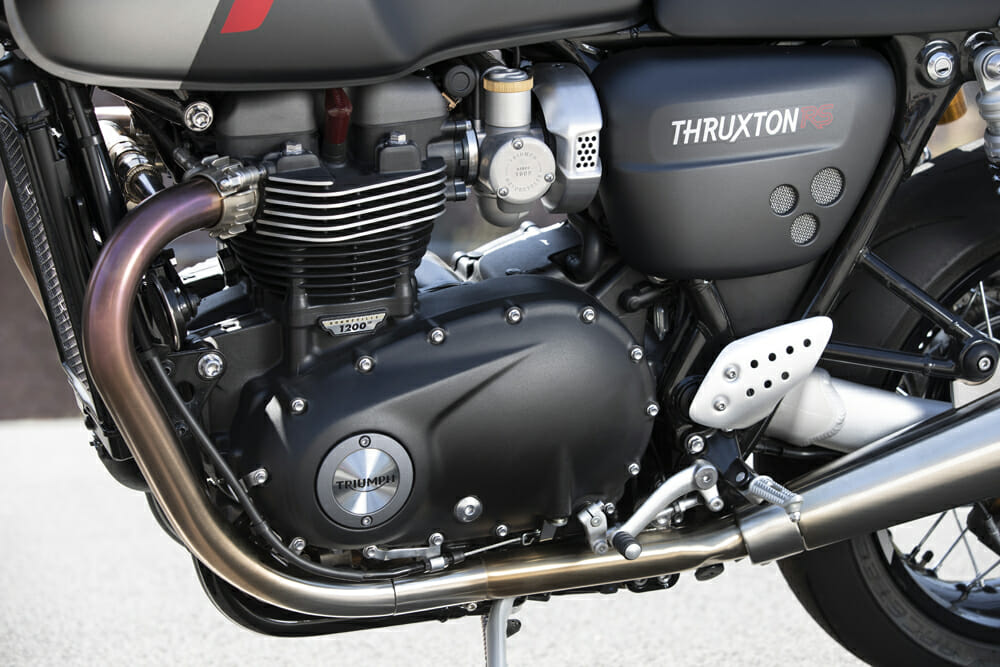
The non-switchable ABS is thankfully non-intrusive, only chipping in its two cents’ worth when it spots the gravel on the road that you didn’t, like a sleeping passenger in a car who only wakes to stop you pulling out in front of that speeding truck and is back asleep again before you’ve finished cursing. I could criticize the fact that when landing a wheelie before a turn, there’s always a moment’s delay in braking while the ABS figures out what’s going on, but I feel like maybe that’s a self-inflicted issue—see previous comments on sportbike nonsense. The RS also features switchable riding modes, tweaked and polished from the older version; the default Road mode is smooth, clean and enjoyable. Sport mode makes you ride too fast, Rain mode fails to make your denim waterproof.
The bikes on the launch were all single-seat options, the standard configuration for the RS. In the U.S., Triumph offers an accessory pillion kit, with a dual seat and passenger footrests. British riders don’t get that option, presumably because riding in the cold and wet on your own is bad enough, without inflicting that misery on a second person. The RS comes in two color options: gloss black or the matte-finish grey and silver. The latter option was definitely the one that had me ordering a second impossibly strong Portuguese coffee so I could sit and stare at it a while longer.
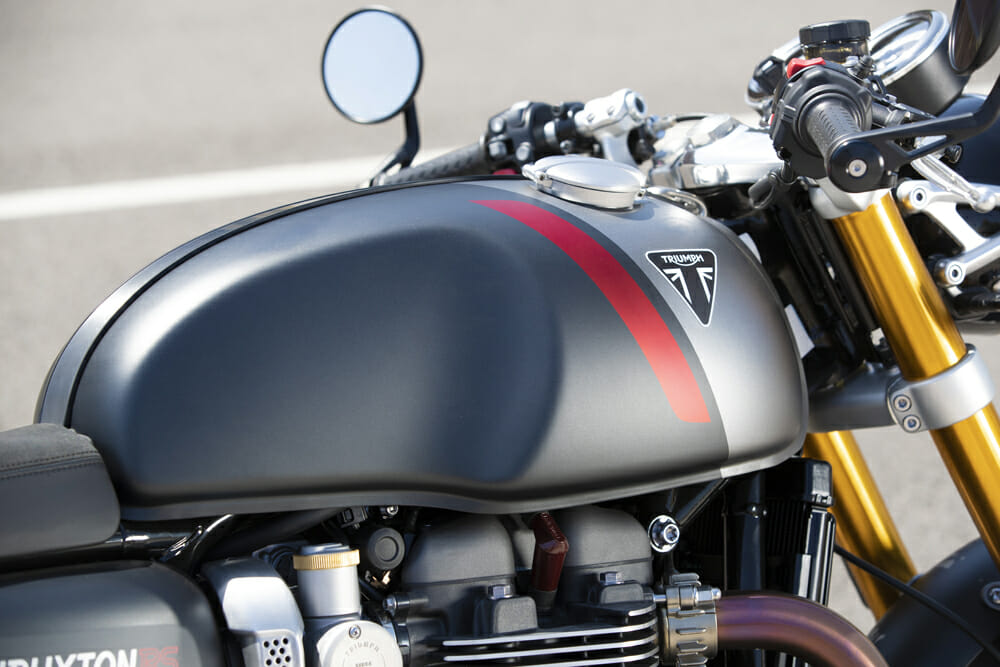
A Gent in Sportbike Clothing
As nice as the Thruxton is to look at, you really do have to get on one for a ride; it is an absolute blast. But first some context. For all the sportbike comparisons and excited superlatives, the Thruxton RS isn’t going to be outlapping any superbikes at a racetrack. It isn’t as fast as a 600cc supersport, and a Street Triple will happily ride around the outside of it on a fast turn. It does, however, handle better than any other twin-shock steel-cradle-framed production bike I can think of.
And by way of hammering home the point that this bike does more than just pose, who did Triumph employ to lead us around the winding roads of the Algarve? Fashionistas? Some trendy custom-bike builders? Not a chance—they stuck us on the back of a couple of Isle of Man TT racers (Gary Johnson and Joe Ackroyd) and told us to ride as fast as we can.
Well, “ride to your own pace” were the exact words they used, but it’s all a matter of interpretation. And ride we did, exploiting the impressive ground clearance, enjoying the glut of grip from the newly spec’d Metzeler Racetec tires and riding the Thruxtons like they were the very race machines that first wore the name.
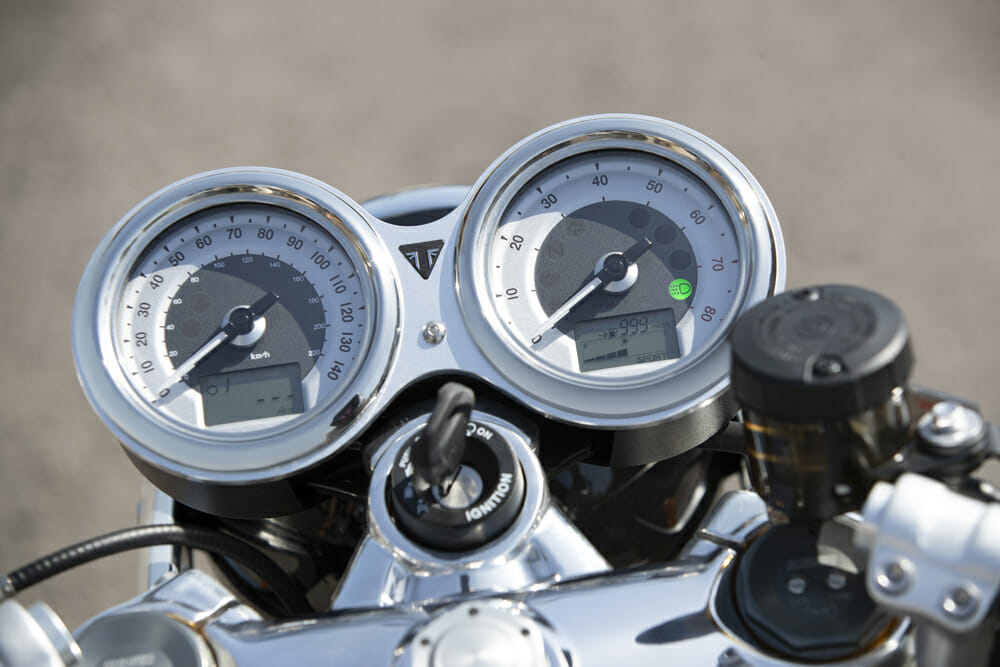
Riding the RS fast takes effort; it won’t fall on its side and change direction without thinking—you have to get off your backside and do it. This is no flimsy modern superbike, flitting between corners with agility bordering on indecision. The Thruxton needs to be ridden. You have to push on the ’bars and put it into the turn. You have to haul it up with the powerful Brembo brakes, before driving it out the other side, pulling the throttle right back to the stop. Riding this thing fast is so involving, so rewarding, so, dare I say it, tactile. Damn, and I was doing so well getting this far without using arty, café racer hipster talk.
But it’s true in this case, the Thruxton will hustle through the bends at a pace higher than it has any right to run, but it involves you in the process in a way that a modern sportbike doesn’t. Perhaps the best way to describe it is that you feel like you are taking the RS and making it go that fast, whereas on the road, a supersport 600 often gives the impression that it could go a lot faster if it could get the sweaty idiot off its back.
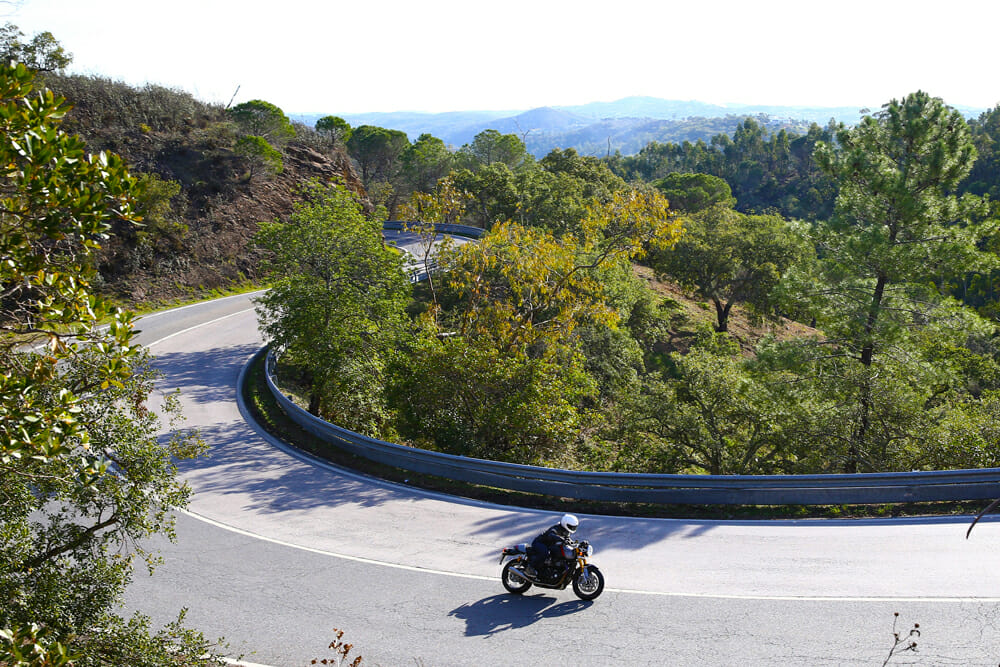
The riding position on the Thruxton RS is not a touring-friendly one. If you want to sit up, cruise along and enjoy the view, there are better options. Like convincing your friends to buy a Thruxton RS for touring and then enjoying the view of it from the seat of something with higher ’bars and a little more seat foam. But use it for what it was intended for, use it to find the most corners possible between coffee stops and you’ll ride all day without trouble. You have to embrace the racing-crouch mind, there is no getting out of it, so don’t fight it—drop your elbows, hunker down and get after it.
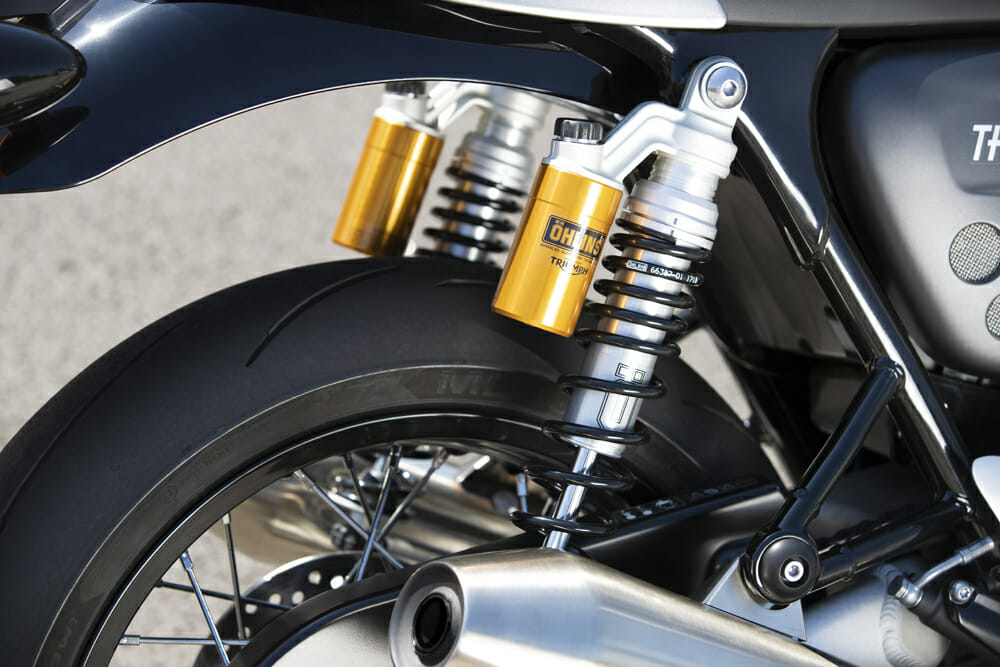
Things We Didn’t Like
In all honesty, there aren’t many. Maybe the $16,200 price tag feels a little strong, but then again maybe that’s the tight ass in me that doesn’t understand inflation and can still remember a new R1 costing less than $15 grand. The new Rocket III has set the bar really high for the level of finish and attention to detail achievable in a motorcycle that comes out of a factory rather than an enthusiast’s workshop.
The Thruxton RS is considerably more affordable than a Rocket, but still, a couple of visual details nagged at me. The big, black plastic switchgear works just fine, but next to the gorgeous polished top clamp, it sits like an oil stain on a white tee shirt. Likewise, the wires from those switch-cubes dangle across to the headstock like phone lines in a crowded Asian city. Sorry Triumph, I’m nit-picking here, but you guys made this well-finished rod for your own backs.
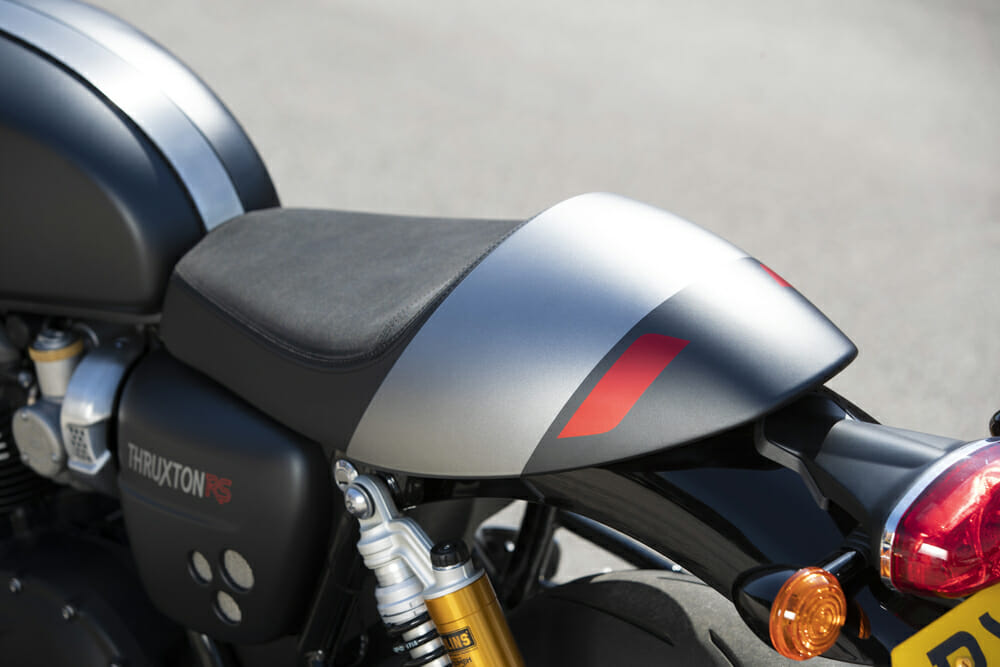
Worth it
In an era where bikes and the media around them have an unnerving ability to make your endeavors feel woefully inadequate, the Thruxton RS and machines of its ilk are a blessing.
Adventure bikes scoff at our 100-mile road trip with a dash of gravel track, while Instagram stories of hardy adventurers battling with the Moroccan desert remind us just how normal we are.
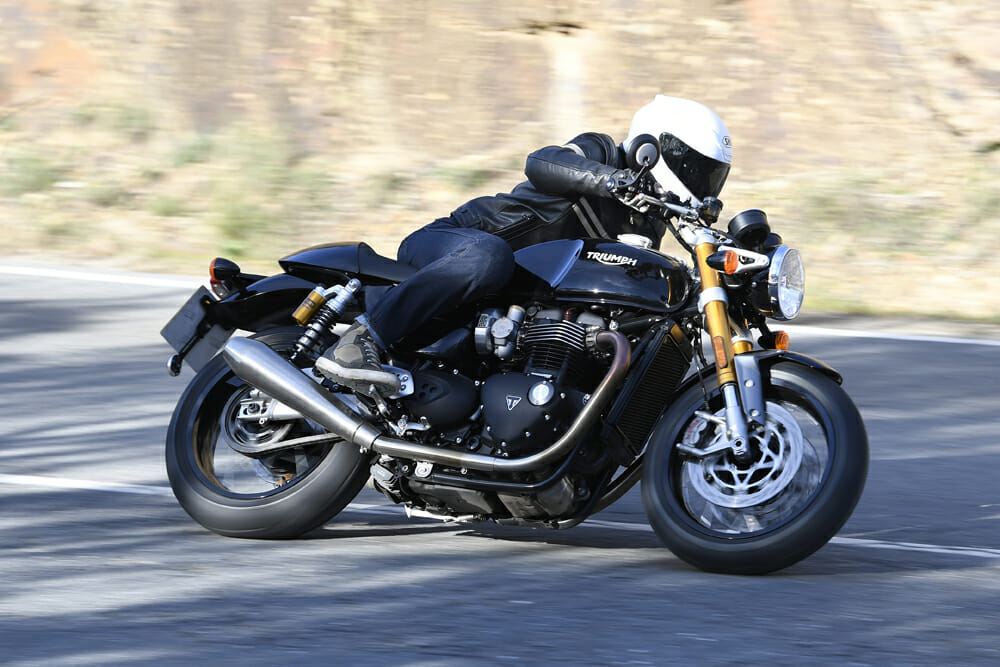
Supersport bikes mock our hopefully dangled knees while we stare at the same machines painting slidey black lines out of racetrack corners at go-directly-to-jail speeds. Yet riding this beautiful bike, on beautiful roads in the presence of some obscene riding talent, there was nothing but enjoyment. No egos getting dented about losing sight of the bike in front, no fuel-stop bull about how you would’ve gone faster but… just a bunch of riders chasing apexes and enjoying the simple pleasure of making a bike go around corners fast.
The Thruxton R was a damn good bike, and in making the RS, Triumph has taken it, listened to feedback from riders, and made it a better bike for riding on the road. That’s not game changing. That’s not genius. That’s not pushing the boundaries of technology or performance. That’s what I love about it—a simple bike, made better. Simply brilliant. CN
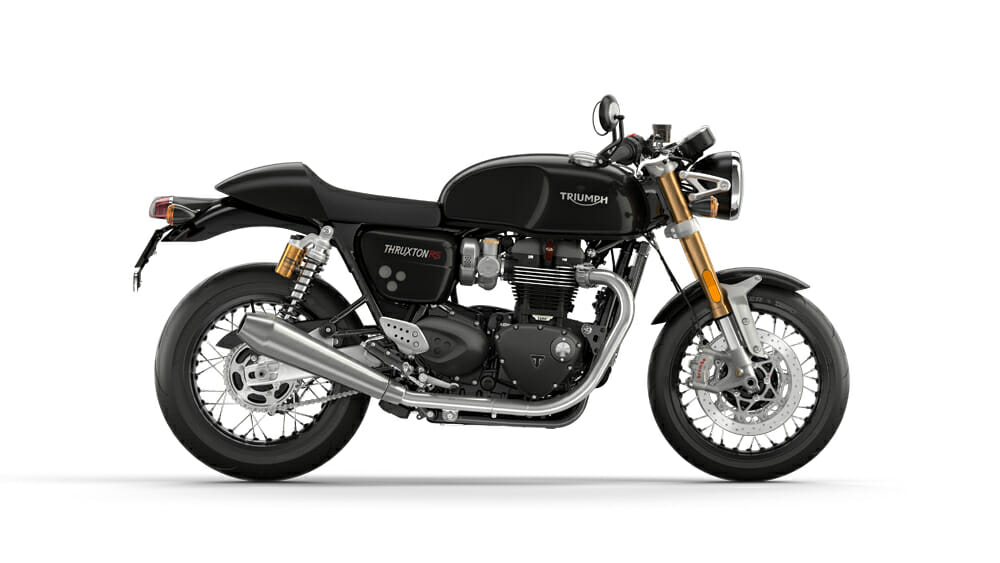
2020 Triumph Thruxton RS Specifications
| MSRP: | $16,200 |
| Engine Type: | Liquid-cooled, 8-valve, SOHC, 270° crank angle parallel-twin |
| Displacement: | 1200cc |
| Bore x Stroke: | 97.6 x 80mm |
| Compression ratio: | 12.0:1 |
| Max Power: | 103 bhp @ 7500 rpm |
| Max Torque: | 82.6 ft.-lbs. @ 4250 rpm |
| Starter: | Electric |
| Transmission: | 6-speed |
| Fuel System: | EFI |
| Clutch: | Wet, multi-plate assist clutch |
| Frame: | Tubular steel cradle |
| Subframe: | Steel |
| Front Suspension: | Showa 43mm USD big piston forks, fully adjustable. |
| Rear Suspension: | Fully adjustable Öhlins twin shocks with Piggyback reservoir |
| Front-wheel travel: | 4.7 in. |
| Rear-wheel travel: | 4.7 in. |
| Front brake: | Twin 310mm Brembo floating discs, Brembo M50 four-piston radial monobloc calipers, ABS |
| Rear brake: | Single 220mm disc, Nissin twin-piston floating caliper, ABS |
| Front wheel: | 32-spoke 17 x 3.5 in., aluminum rim |
| Rear wheel: | 32-spoke 17 x 5 in., aluminum rim |
| Front tire: | 120/70 ZR17 |
| Rear tire: | 160/60 ZR17 |
| Rake: | 22.8 |
| Wheelbase: | 55.7 in. |
| Seat height: | 31.8 in. |
| Fuel capacity: | 3.8 gal. |
| Weight (dry, claimed): | 434 lbs. |
| Color: | Black, grey/red |
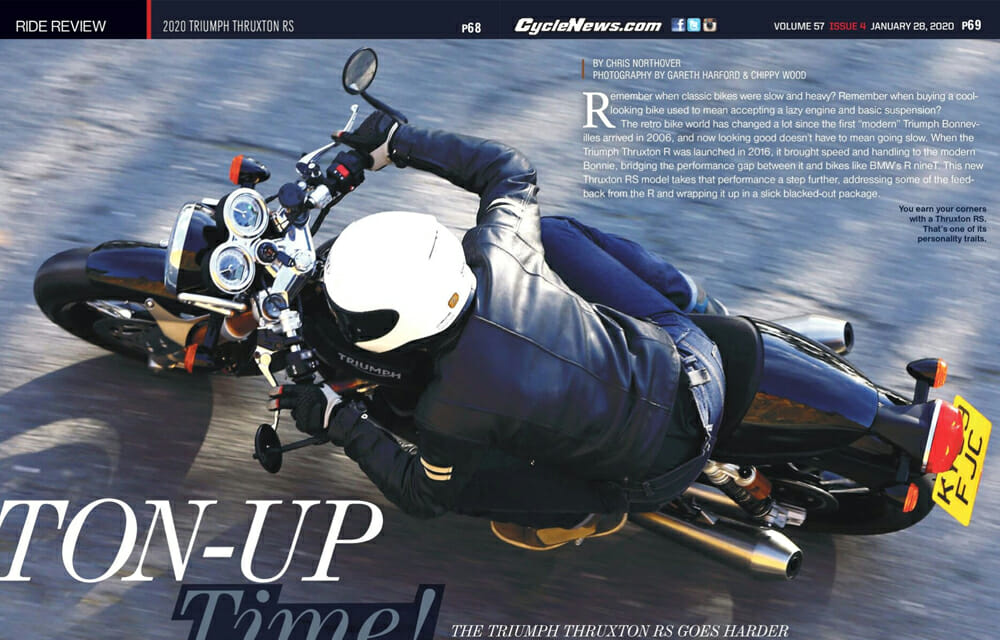
Click here to read this in the Cycle News Digital Edition Magazine.
Click here for the latest Cycle News Sportbike motorcycle reviews and news.
Click here for more Triumph motorcycle reviews and news.
